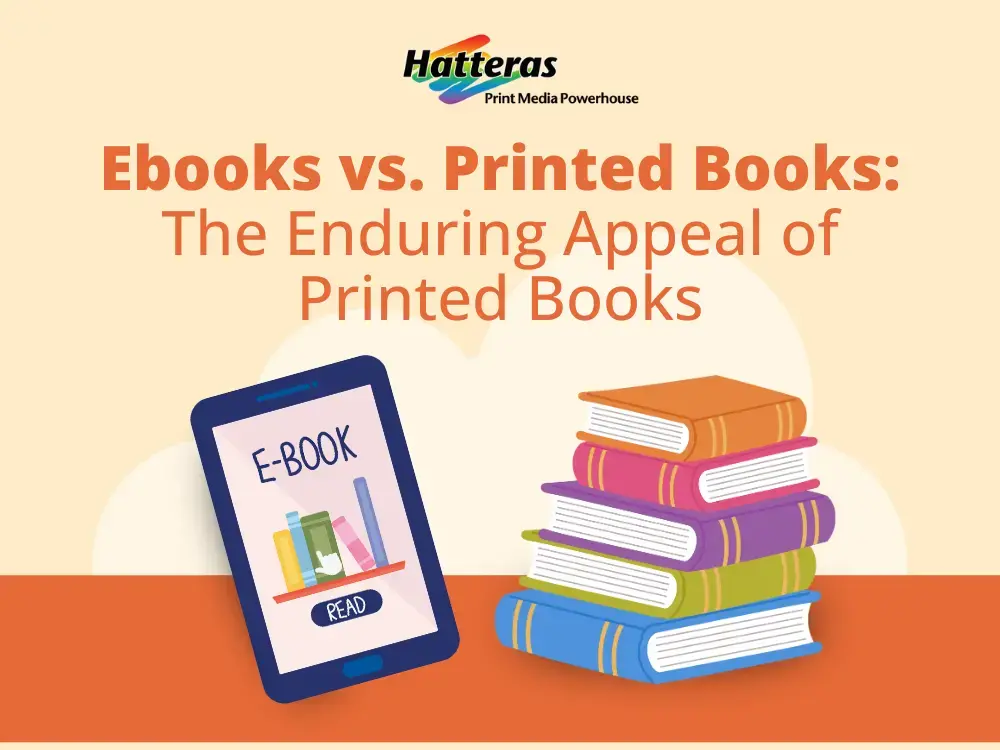
In today’s digital age, the debate between e-books vs. printed books remains a hot topic among readers and book lovers. While e-books have revolutionized the way we consume literature, offering convenience and accessibility, many readers continue to gravitate toward the tactile experience of printed books.
This blog explores the merits and drawbacks of each format to understand why printed books maintain their timeless appeal for readers.
The Rise of E-Books
E-books, or electronic books, trace their origins back to the early days of computer technology.
1971: Project Gutenberg
Michael S. Hart is credited with creating the first e-book when he launched Project Gutenberg in 1971. The project began with Hart digitizing the U.S. Declaration of Independence and making it available on the ARPANET (a precursor to the internet). This initiative aimed to make literary works freely available in digital format.
1980s-1990s: Early E-Readers
The development of dedicated e-reading devices started during this period:
-
In 1986, Franklin Computer Corporation released the first handheld electronic dictionary, which paved the way for portable electronic text devices.
-
In the early 1990s, companies like Sony introduced electronic text display devices.
1998: The Rocket eBook and SoftBook
The late 1990s saw the first commercial e-readers:
-
Rocket eBook and SoftBook were among the earliest dedicated devices designed specifically for reading e-books. These devices could store multiple books but were expensive and had limited adoption.
2000s: Mainstream Adoption
The e-book market gained significant traction in the 2000s:
-
2007: Amazon launched the Kindle, a game-changer for the e-book industry. The Kindle’s user-friendly design, affordable e-books, and access to a vast library of titles made e-reading mainstream.
-
2010: The release of Apple’s iPad further boosted e-books, providing a multi-functional device that doubled as an e-reader.
E-books, or electronic books, emerged as a game-changing innovation in the publishing world. With the advent of e-readers like Amazon’s Kindle, Barnes & Noble’s Nook and platforms such as Apple Books and Google Play Books, digital reading has become more accessible than ever. Here are some key advantages of e-books vs. printed books:
-
Portability - E-books allow readers to carry an entire library in a single device.
-
Cost-Effectiveness - E-books are often affordable.
-
Instant Gratification - With e-books, readers can purchase, download, and start reading within seconds.
-
Environmental Impact - Advocates for e-books often cite their eco-friendliness, although this is debatable.

The Enduring Charm of Printed Books
When considering ebooks vs printed books, printed books hold a special place in readers’ hearts. Here’s why:
1. Tangibility
Printed books offer a sensory experience that e-books cannot replicate. The weight of a book, the feel of its pages, and even the smell of fresh or aging paper evoke a sense of nostalgia and connection to the content.
2. Aesthetic Value
When it comes to aesthetics, it’s clear the winner between ebooks vs printed books. Bookshelves adorned with colorful spines and well-loved volumes add character to a room. For many, books are not just tools for reading, but cherished possessions that reflect personal tastes and history.
3. No Eye Strain
Unlike screens, printed books do not emit blue light, making them easier on the eyes during extended reading sessions. This is especially important for avid readers who spend hours engrossed in a book.
4. Reliability
Printed books require no batteries, updates, or internet connections. They are always ready to be read, making them a dependable choice in any setting. Reliability is a key aspect when comparing ebooks vs printed books.
5. Less Screen Time and Distractions: A Retreat from Technology
In an age dominated by digital screens and constant connectivity, printed books offer a welcome respite from technology. Reading a printed book allows readers to unplug, disconnect from screens, and immerse themselves in a focused, uninterrupted reading experience. This break from digital distractions can be valuable for reducing eye strain, improving sleep quality, and promoting overall well-being.
Some studies suggest reading comprehension and retention may be higher when reading from printed material than from digital screens. The tactile nature of printed books may facilitate deeper cognitive processing and understanding of the content, contributing to a more enriching and memorable reading experience.
6. Collectibility and Sentimental Value
Printed books often become cherished items to collect and display. For book collectors, first editions, signed copies, or books with historical significance hold intrinsic value and can become prized possessions. The physical presence of a well-curated bookshelf or personal library can evoke a sense of pride and accomplishment for avid readers.
Beyond their monetary or collectible value, printed books also carry sentimental significance. They can evoke memories of where and when they were acquired, gifted, or read. Many readers have fond recollections of browsing through bookstores, stumbling upon hidden literary gems, or receiving a meaningful book as a gift, which enhances their emotional attachment to printed books.
7. Emotional Connection
Flipping through pages, marking favorite passages, or handing down a treasured book to future generations creates an emotional bond that is difficult to replicate digitally. Printed books are not merely carriers of text but also works of art. Publishers invest significant effort into designing visually appealing covers, selecting quality paper, and creating layouts that enhance readability and aesthetic appeal. The artistry in book design contributes to the pleasure of owning and reading a printed book.
From elaborate typography that sets the tone for a narrative to intricate illustrations that bring stories to life, printed books offer a visual feast that complements and enriches the reading experience. The ability to physically interact with these artistic elements adds a layer of appreciation and immersion that enhances the storytelling or informational content of the book.
8. Accessibility: Books for All
While ebooks offer unparalleled convenience in portability and instant access, printed books ensure accessibility for readers of all ages and technological backgrounds. Not everyone can access digital devices or reliable internet connections, especially in less developed regions or underserved communities. Printed books are a reliable and familiar resource for accessing knowledge, stories, and information without technological barriers.
In educational settings, printed textbooks remain essential for students, providing a tangible resource for studying, referencing, and engaging with course materials. The physical presence of textbooks in classrooms supports learning environments and accommodates diverse learning preferences and needs.
The Tactile Experience: Ebooks vs Printed Books
One of the most compelling arguments in favor of printed books vs ebooks is the tactile experience they provide. There's a visceral pleasure in holding a physical book, feeling the texture of the paper beneath your fingertips, and flipping through the pages. The weight of the book, the sound of pages turning, and the act of physically marking your progress with a bookmark all contribute to a sensory engagement that ebooks simply cannot replicate.
This tactile interaction enhances the overall reading experience for many readers, creating a deeper connection between the reader and the text. Whether it's the crisp pages of a new hardcover or the well-worn feel of a beloved paperback, the physicality of printed books adds a dimension of intimacy and enjoyment to the act of reading.

Ebooks vs. Printed Books: Embracing the Best of Both Worlds
In conclusion, while ebooks have revolutionized how we consume literature and information, printed books are still very much relevant today. The tactile experience, visual aesthetics, collectibility, sentimental value, and a break from screen time are compelling reasons many readers prefer printed books.
Ultimately, whether you favor the convenience of ebooks or the timeless appeal of printed books, what matters most is the joy and enrichment that reading brings to our lives. As technology continues to evolve, the coexistence of both formats ensures that readers have diverse options to suit their preferences and lifestyles. Which do you prefer? Send me a note at bzbozen@4hatteras.com
Related Posts
A Breakdown of Book Printing Layouts: A Books Anatomy
Books are more than just the sum of their words. Books have been a cornerstone of human...
The Disadvantages of E-books | E-books vs Printed Books
E-books have transformed the reading landscape, offering readers unparalleled convenience and...
Tips For Choosing the Best Book Printer
Choosing the best book printer is critical for authors and publishers alike. It directly impacts...

